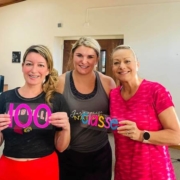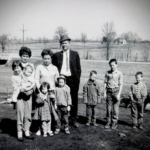It’s Time to Give Women a Crack at it! | Healthy Aging Series: S11 E22
I am A Social Worker
I moved to Louisville 30 years ago to attend Social Work School. It seemed like a good decision considering I had spent the previous 15 years becoming disenchanted with being a Baptist Minister.
I was still going to help people, but this time with an emphasis on social justice-social policy. Anne Davis, founder of the Carver School Church Social Work told the social-work parable about walking up to a river and seeing someone floating down river and screaming for help. You rescue them, and then you notice another. You rescue them, and then comes another, and then another, and another person that needs to be rescued.
After a bit of rescuing, you walk upstream and try to figure out what’s causing all these people to end up in the river in the first place and you work at solving that problem.
That was a parable of Upstream-ism or macro-Social Work.
People ask me why I left the ministry. I tell them that I really didn’t leave the ministry, not really. And then I tell them I left because, for me, Social Work was a better way of helping people. Maybe, it was a better way because it was a kinder way.
Mark, You Need a Female Supervisor!
While attending Social Work School, I did my first practicum at St. Vincent de Paul homeless shelter. It was a wonderful experience. During my final evaluation, my supervisor, Steve Williams, recommended something that, at the time, I did not understand. He said, “Look Mark, you’re an older male student and you’ve had a lot of experience, raised in a small town, four years in the Air Force, 15 years in the Baptist ministry, and because of those things, you need to seek out women as supervisors. In part, they are going to help you deconstruct your current worldview, one that’s been dominated by men, and then they will help you construct a new worldview, a view of the world that is full of people who suffer due to the men in your former worldview.” Sorry, not sorry, men!
Eek!! I didn’t have a clue what he was talking about. I had a great relationship with my mother and my four sisters. I never oppressed women, or at least I hoped I hadn’t.
And now, 33 years later, I see it.
There’s something overly masculine about our country and world. What am I talking about? I’m talking about brute force. I’m talking about our lack of tolerance. I’m talking about the failure to help the less fortunate. And I’m talking about putting profits above people. War and corruption are at an all-time high, and it’s mostly men in charge, mostly wealthy men. We are living in the Upside-Down World. People don’t matter. We don’t care about going upstream and figuring out what’s causing all the social problems in our country. This isn’t an anti-man indictment, and it isn’t anti-masculine, rather, it’s:
“let’s balance out the masculine with the feminine, the hard with the soft.”
So maybe, just maybe, it’s time to give women a crack at running things. Maybe it’s time for a more feminine approach.
The Perfect Example: The Women’s Fitness Revolutionaries
OK, I’m going to pivot in an ever so slightly different direction, and then come back to “bring the world back to balance” at the end.
I’ve been writing about Fitness Revolutionaries, mostly men. Now I want to look at the women who have changed the way other women exercise.
I want to talk about the Female Revolutionaries who changed the culture in our country and even the world.
Things are Really, Really Different in the Women’s Fitness World Today
First, I think we take for granted all the changes that have taken place over the past 50 years in the fitness world.
As an example, women didn’t run in the Olympic Marathon until 1984. The same with cycling. The NCAA began sponsoring women’s basketball in 1982.
Think about those exercise groups and centers that never existed until the late 60s through the early 80s like Jazzercise, Dance Aerobics, Aerobicize, Dancercise, and later, Step Aerobics, all in the 70s and 80s, and Zumba in the early 2000s.
Most, if not all, were started by women, and though not limited to women, women were the primary focus of these programs. And even though many have embedded resistance training in their workouts, most focus on aerobics and cardiovascular health.
I’ve written about Dr. Kenneth Cooper and his book, Aerobics. He provided the science for the women’s fitness revolution. There were four women who took that science and then turned it into fun. They turned it into dance. They turned it into a social support system for women. They turned it into something that appealed mostly to women as opposed to those powerhouse gyms that focused on pumping iron.
The Four Revolutionaries
It’s as if someone said, we’ve let men have a go at it; designing a one-size-fits-all fitness program for everyone, and now, maybe it’s time we let women have a crack at it. Maybe it’s time we let women design a fitness program for women, and in the late 60s and through the 70s and into the 80s, there were four women who answered the call.
Jackie Sorensen
Jackie grew up dancing, and as a young woman began teaching dancing. She was a disciple of Dr. Kenneth Cooper, who I’ve mentioned, who recommended aerobic exercise for a healthy heart. After consulting with Dr. Cooper, she began teaching aerobic dance classes. She discovered that her female students reduced their waist lines and lost excess weight. Later, she took her classes to the YMCA. During 1971 she trained hundreds of instructors to teach aerobic dance. In 1973 she opened an Aerobic Dance Center in San Diego. By 1977, 30,000 people had taken classes at that center. By 1981, she had trained 4,000 students at 1,500 locations with 170,000 students enrolled. Today, the Sorenson Aerobic Dancing style is taught in Jackie’s Dance and Strong Step classes in Australia, Japan, and in the United States.
Lucille Roberts
“Inspired by a love of aerobic classes and a dream,” shares the official website, “Lucille Roberts opened her first gym in 1969. She had taught what seemed like millions of group exercise classes before realizing that the classes were predominantly women. “The fitness clubs lacked the camaraderie that women craved.” So, she started a center that was called, “The Women’s Gym.” At its height, the “Lucille Roberts” brand had more than 15 locations in New York City. Her gyms helped set off the fitness craze that would revolutionize women’s health. Lucille provided a place for women to work out. There is one gym that remains with a very loyal clientele. “All of us hope this gym never closes.” Says one loyal participant, “it’s not like other gyms. It’s a community for women.” Alex Vadukul, New York Times, May 21, 2025. At its height, Lucille Roberts had an annual revenue of $50 million with 200,000 members. She wanted to provide an affordable fitness experience for women. One of her specials was $8.95 per year.
Judi Missett
Around the same time that Sorenson and Roberts were changing the fitness culture in America, Judi Missett added her influence and leadership that would form a mega movement and would last for 50+ years. Jazzercise is a force in the world. Judi grew up dancing. She became a dance instructor as a teenager. She loved dancing. It was her passion. She describes herself as having a heart full of passion for dance and a head full of dreams. So, in 1969, at age 25, she started teaching classes and she called it Jazzercize. Originally described as jazz dance, she promoted it for fun and fitness. Today, the company currently has over 8,300 franchises in 32 countries, with over 13 million members. It’s annual revenue in 2023 was $100 million. My wife is a Jazzerciser. Much of her life revolves around her class schedule. She could easily be an instructor, but she loves it so much that she chooses to remain a student. She’s made many friends through Jazzercise. Thank you, Judi Missett.
Jane Fonda
Jane Fonda loved dancing and ballet. But in 1978, after breaking a bone in her ankle, she was forced to seek out a different fitness regimen that would help her manage her weight without stressing her ankle. It involved dancing. She partnered with her dance instructor and then they opened a studio. Soon after, she wrote a book, the Jane Fonda Workout, which sold 2 million copies. A video followed, which sold 17 million copies, becoming one of the best-selling home video series of all time. This success helped usher in the home fitness craze and cemented Fonda as a fitness icon. The VCR/VHS industry attributes much of it success to Fonda’s videos. Carol Espel, the National Director of the Equinox Group said of Fonda, “She opened the door for those who were either dancers or interested in fitness to become professionals, and created an industry. She helped legitimize fitness as a viable business.”
These four women change the world. They were revolutionaries, and the revolution they started was by and for women. They lived in a world that had been shaped and driven by men. Sorry guys. Women finally took a crack at it and changed the fitness culture. They made fitness fun and welcoming for women. Women were meeting the needs of women. There were many, many other women involved in this process.
The World Today
I look at the world and I’m worried. Maybe it’s because women have been excluded from the process of shaping our world and shaping our culture. The world looks much like the gym, cluttered with heavy weights and squat racks.
Maybe it’s time to see what women can do, maybe it’s time to give them a crack at it. We need a different approach to doing things in this country and in this world.
Women answered the call in the 60s, 70s and 80s in the fitness world, and my hope is that they’ll answer a new call to help change a country that is stuck lifting weights, trying to see who has the biggest biceps.
My hope is they’ll change it into a world that focuses on camaraderie, mutual support, and getting strong.













